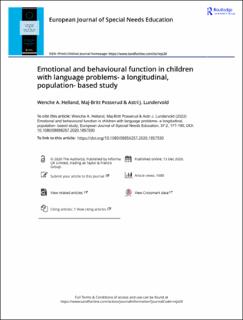| dc.contributor.author | Helland, Wenche A | |
| dc.contributor.author | Posserud, Maj-Britt Rocio | |
| dc.contributor.author | Lundervold, Astri | |
| dc.date.accessioned | 2021-04-26T08:55:41Z | |
| dc.date.available | 2021-04-26T08:55:41Z | |
| dc.date.created | 2020-12-16T15:33:39Z | |
| dc.date.issued | 2022 | |
| dc.identifier.issn | 0885-6257 | |
| dc.identifier.uri | https://hdl.handle.net/11250/2739500 | |
| dc.description.abstract | This longitudinal, population-based study investigated associations between language problems (LP) and emotional and behavioural difficulties (EBD). Parents and teachers gave information about LP and EBD when the children were 7–9 (T1) and 11–13 years old (T2). Self-reports of EBD were included at T2. In line with findings from clinically referred samples, children with LP scored higher than controls on all measures of EBD at both time-points. A subgroup with persistent LP showed more severe EBD than a subgroup with transient LP. Hyperactivity and peer problems at T1 were significantly associated with the risk of persistent LP. Boys in the persistent subgroup had more severe behaviour problems as reported by all informants, whereas self-reports revealed more severe emotional problems in girls with LP. The profound and consistent reports across informants of EBD in children with LP emphasise the importance of providing both mental health and language support in childhood as well as in adolescence. Addressing symptoms associated with Attention Deficit Hyperactivity Disorder and social problems may be of especial importance to improve LP outcome. The complexity of problems encountered underlines the need for a combined expertise and multidisciplinary approach to language impairment in youth. | en_US |
| dc.language.iso | eng | en_US |
| dc.publisher | Routledge | en_US |
| dc.relation.uri | https://www.tandfonline.com/doi/epub/10.1080/08856257.2020.1857930 | |
| dc.rights | Navngivelse 4.0 Internasjonal | * |
| dc.rights.uri | http://creativecommons.org/licenses/by/4.0/deed.no | * |
| dc.title | Emotional and behavioural function in children with language problems- a longitudinal, population- based study | en_US |
| dc.type | Journal article | en_US |
| dc.type | Peer reviewed | en_US |
| dc.description.version | publishedVersion | en_US |
| dc.rights.holder | Copyright 2020 The Author(s) | en_US |
| cristin.ispublished | true | |
| cristin.fulltext | original | |
| cristin.qualitycode | 2 | |
| dc.identifier.doi | https://doi.org/10.1080/08856257.2020.1857930 | |
| dc.identifier.cristin | 1860640 | |
| dc.source.journal | European Journal of Special Needs Education | en_US |
| dc.source.pagenumber | 177-190 | |
| dc.identifier.citation | European Journal of Special Needs Education, 2022, 31 (2), 177-190. | en_US |
| dc.source.volume | 37 | |
| dc.source.issue | 2 | |

